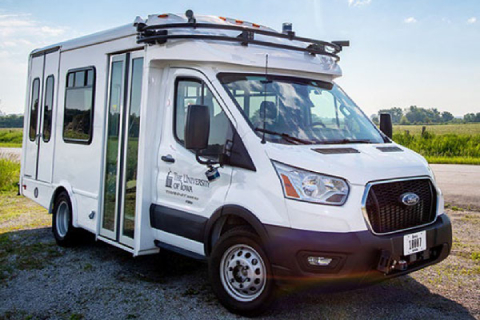By Dar Danielson (Radio Iowa)
A just completed study at the University of Iowa’s Driving Safety Research Institute found there is more work to be done to create an automated vehicle that can safely navigate on Iowa’s rural roads.
Institute Deputy Director Omar Ahmad says the study is the first of its kind. “Most of the testing is taking place in larger urban areas, or on interstates. But the fact is, that while a smaller portion of the population lives in rural areas, half of all traffic fatalities occur on rural roadways,” Ahmad says.
One of the goals of the research was to see if automated vehicles can provide help to elderly residents with mobility, vision, or other challenges who can’t drive themselves. Ahmed says they created an automated shuttle bus designed to deal with the unique situations in rural driving, like navigating on gravel. “You drive a gravel roadway in the center of the road and then you give way as you approach somebody and then you more or less go back to the center because that’s the best part of the gravel roadway,” he says. “As you get towards the edge, the gravel starts to get looser, and especially in bad weather, it can almost pull you in or off the road.”
He says their automated vehicle had trouble discerning when to move to the middle of the gravel, especially in wet weather conditions. “It would stay towards the edge regardless of whether the weather was good or bad,” Ahmed says. “And we would want it to be smarter like a human and drive more towards the center and only go towards the edge when it sees somebody approaching.”
The automated vehicle also had trouble sensing what was a hazard and what was not — sometimes slowing down for dust clouds created on gravel roads. Another issue came at intersections with low visibility, or where the rural road came to a highway. “If the sensors can’t see around the corner, or because the traffic is moving so fast, if they don’t see the traffic until it’s almost too late, that can be very challenging. And that was certainly something that we experienced, as we were making turns onto highways where we were at a stop sign and the traffic was approaching really fast,” he explains, “our sensors weren’t able weren’t look far enough ahead in either direction.”
They used a safety driver in the bus as they drove a 47-mile route multiple times a week, round trip between Iowa City, Hills, Riverside, and Kalona. For each drive, the bus began and ended the route at one of the four pre-arranged locations to pick up residents who were volunteer research participants.
Ahmad says they collected a lot of data and says there is a lot of work ahead. “The technology has a lot of potential, it has a lot of promise, but it’s simply not there yet in terms of its reliability to be able for us to feel confident driving without a safety driver,” he says. Ahmad says there is a lot of potential for automated vehicles to make a driver safer, but taking the driver completely out of the equation is not going to happen anytime soon. “They are not yet a replacement for the driver. And I would say it’s fairly hard to predict when they will be, but my own personal guess would be that it will be quite some time,” Ahmad says.
The U.S. Department of Transportation awarded eight institutions a $7 million grant for automated vehicle research. Ahmad says the U-I was one of three to study rural driving conditions, and the first of the three to complete the data collection portion of their project. He says they will now share the good and bad issues they found with rural roadways and automation with the other institutions.




